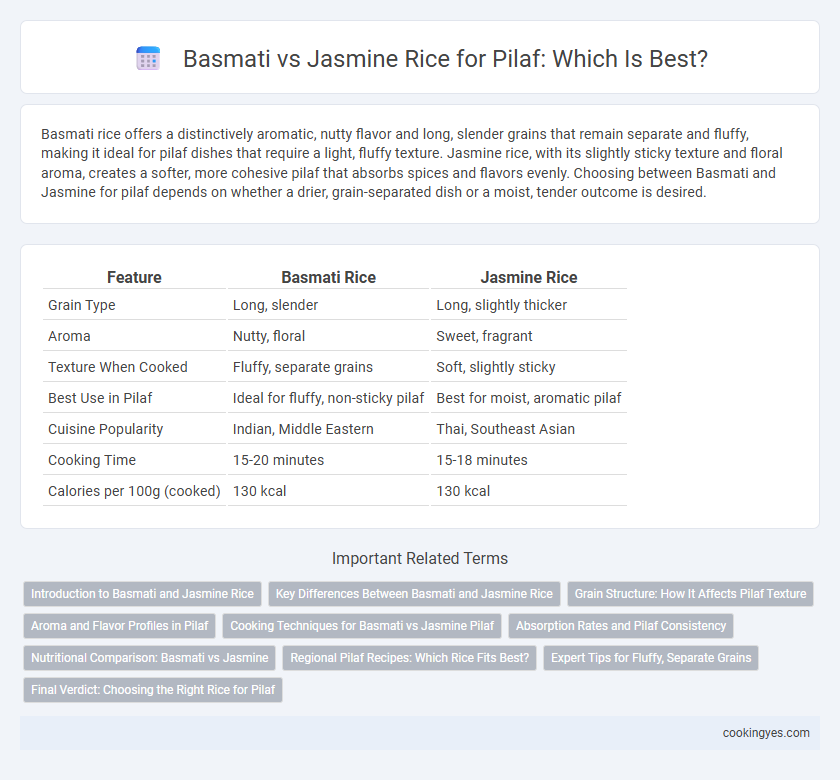Basmati rice offers a distinctively aromatic, nutty flavor and long, slender grains that remain separate and fluffy, making it ideal for pilaf dishes that require a light, fluffy texture. Jasmine rice, with its slightly sticky texture and floral aroma, creates a softer, more cohesive pilaf that absorbs spices and flavors evenly. Choosing between Basmati and Jasmine for pilaf depends on whether a drier, grain-separated dish or a moist, tender outcome is desired.
Table of Comparison
| Feature | Basmati Rice | Jasmine Rice |
|---|---|---|
| Grain Type | Long, slender | Long, slightly thicker |
| Aroma | Nutty, floral | Sweet, fragrant |
| Texture When Cooked | Fluffy, separate grains | Soft, slightly sticky |
| Best Use in Pilaf | Ideal for fluffy, non-sticky pilaf | Best for moist, aromatic pilaf |
| Cuisine Popularity | Indian, Middle Eastern | Thai, Southeast Asian |
| Cooking Time | 15-20 minutes | 15-18 minutes |
| Calories per 100g (cooked) | 130 kcal | 130 kcal |
Introduction to Basmati and Jasmine Rice
Basmati rice, known for its long, slender grains and aromatic fragrance, originates from the Indian subcontinent and is prized for its fluffy, separate texture when cooked, making it ideal for pilaf dishes. Jasmine rice, a fragrant variety from Thailand, has shorter, slightly sticky grains with a subtle floral aroma that adds a delicate flavor to pilaf recipes. Both varieties enhance pilaf with distinct textures and aromas, catering to different culinary preferences.
Key Differences Between Basmati and Jasmine Rice
Basmati rice, primarily grown in the Indian subcontinent, is known for its long, slender grains and nutty aroma, making it ideal for pilaf dishes that require fluffy, separate grains. Jasmine rice, originating from Thailand, features shorter, stickier grains with a subtly sweet fragrance, providing a creamier texture when cooked. The key difference lies in the grain length and texture, where Basmati's drier, fluffier quality contrasts with Jasmine's moist, slightly sticky consistency, influencing the final pilaf texture.
Grain Structure: How It Affects Pilaf Texture
Basmati rice has long, slender grains that remain separate and fluffy when cooked, making it ideal for pilaf where distinct grain texture is desired. Jasmine rice features shorter, slightly stickier grains that tend to clump together, resulting in a softer, more cohesive pilaf texture. The grain structure directly impacts aeration and moisture absorption, influencing the final mouthfeel and presentation of pilaf dishes.
Aroma and Flavor Profiles in Pilaf
Basmati rice offers a distinctive nutty aroma and fluffy texture that enhances pilaf with a fragrant and slightly floral flavor, ideal for dishes requiring a delicate yet pronounced scent. Jasmine rice provides a naturally sweet, floral aroma and a softer, stickier texture, delivering a slightly buttery and aromatic profile that complements richer, creamier pilafs. Choosing between Basmati and Jasmine depends on whether the desired pilaf has a light, airy complexity or a more moist, fragrant richness.
Cooking Techniques for Basmati vs Jasmine Pilaf
Basmati rice requires soaking for 30 minutes to reduce cooking time and maintain fluffy, separate grains, while jasmine rice benefits from a gentle rinse to remove excess starch but does not need soaking to preserve its slightly sticky texture in pilaf. Basmati pilaf is typically cooked using the absorption method with precise water-to-rice ratios and simmering to achieve a drier, fluffier consistency. Jasmine pilaf is often prepared with slightly higher water content and more gentle heat to emphasize its natural fragrance and subtle stickiness, resulting in a tender, cohesive dish.
Absorption Rates and Pilaf Consistency
Basmati rice has a lower absorption rate compared to Jasmine rice, resulting in a fluffier, less sticky pilaf with distinct grains. Jasmine rice absorbs more water, creating a softer, slightly more cohesive pilaf texture. For pilaf consistency, Basmati's firm structure maintains separation, while Jasmine's higher absorption leads to a creamier finish.
Nutritional Comparison: Basmati vs Jasmine
Basmati rice contains approximately 205 calories and 45 grams of carbohydrates per cooked cup, with a lower glycemic index of around 50, making it a better option for blood sugar control compared to Jasmine rice, which provides about 238 calories and 45 grams of carbohydrates per cooked cup and has a higher glycemic index near 68. Both varieties offer similar protein content, roughly 4-5 grams per cup, but Basmati rice has slightly less fat and higher fiber content, contributing to improved digestion and satiety in pilaf dishes. The micronutrient profiles show Basmati contains more iron and B vitamins, while Jasmine is richer in antioxidants, allowing nutritional choices tailored to dietary needs for pilaf recipes.
Regional Pilaf Recipes: Which Rice Fits Best?
Basmati rice, known for its long grains and nutty aroma, is ideal for traditional South Asian pilaf recipes where fluffy, separate grains are desired. Jasmine rice, with its slightly sticky texture and floral fragrance, suits Southeast Asian pilafs that benefit from a moist, cohesive consistency. Selecting the rice depends on the regional pilaf style, as Basmati enhances the light, dry texture of Indian pilafs while Jasmine complements the aromatic, softer texture of Thai and Vietnamese dishes.
Expert Tips for Fluffy, Separate Grains
For a perfect pilaf, basmati rice is preferred due to its long grains and low starch content, which naturally yield fluffy, separate grains. Experts recommend rinsing basmati thoroughly to remove excess starch and soaking it for 30 minutes before cooking to enhance texture. Jasmine rice, while fragrant, tends to be stickier and less ideal for pilaf, so choosing basmati with precise water-to-rice ratios ensures optimal fluffiness and grain separation.
Final Verdict: Choosing the Right Rice for Pilaf
Basmati rice offers long, slender grains with a fragrant aroma and a fluffy, separate texture ideal for pilaf, absorbing spices well without becoming mushy. Jasmine rice, slightly shorter and more moist, provides a soft, sticky consistency with a floral scent but can result in a denser pilaf. For a classic, aromatic, and fluffy pilaf, basmati is the preferred choice, while jasmine suits creamier, softer rice dishes better.
Basmati vs Jasmine for Pilaf Infographic

 cookingyes.com
cookingyes.com